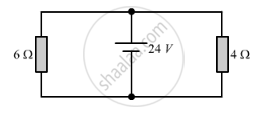Advertisements
Advertisements
Question
Explain with the help of a labelled circuit diagram, how you will find the resistance of a combination of three resistors of resistances R1, R2 and R3 joined in parallel.
Solution

Let the resistance of the three resistors be R1, R2 and R3, respectively. Let their combined resistance be R. Let the total current flowing in the circuit be I and the strength of the battery be V. Then from Ohm's law, we have:
V = IR .....(1)
We know that when the resistors are connected in parallel, the potential drop across each resistance is the same.
Therefore:
I = I1 + I2 + I3
I = V/R1 + V/R2 + V/R3
I = V/(1/R1 + 1/R2 + 1/R3) ...... (2)
From equations (1) and (2) we have:
1/R = 1/R1 + 1/R2 + 1/R3
APPEARS IN
RELATED QUESTIONS
Differentiate between resistances in series and parallel.
The equivalent resistance of the parallel combination of two resistors of 60Ω and 40Ω is _______.
A) 24Ω
(B) 100Ω
(C) 50 Ω
(D) 240Ω
Find the current in each resistor in the circuit shown below:

If current flows through two lamps arranged:
(a) in series,
(b) in parallel,
and the filament of one lamps breaks, what happens to the other lamp? Explain your answer.
Show how would you connect three resistors, each of resistance 6 O so that
the combination has a resistance of(a) 9 Ω (b) 4 .Ω
What are the advantages of a parallel connection?
Explain, why is the p.d. between the terminals of a storage battery less when it is supplying current than when it is on open circuit. A battery of e.m.f. 10 volts and internal resistance 2.5 ohms has two resistances of 50 ohms each connected to it. Calculate the power dissipated in each resistance
(a) When they are in series,
(b) When they are in parallel.
In each case calculate the power dissipated in the battery.
The equivalent resistance of a parallel combination of two resistors of 30 Ω and 60 Ω is ______________.
Assertion: When a battery is short circuited, the terminal voltage is zero.
Reason: In a short circuit, the current is zero.
You are given four ammeters A, B, C and D having the least counts mentioned below:
(I) Ammeter A with least count 0.25 A
(II) Ammeter B with least count 0.5 A
(III) Ammeter C with least count 0.05 A
(IV) Ammeter D with least count 0.1 A
Which of the ammeters would you prefer for doing an experiment to determine the equivalent resistance of two resistances most accurately, when connected in parallel?
